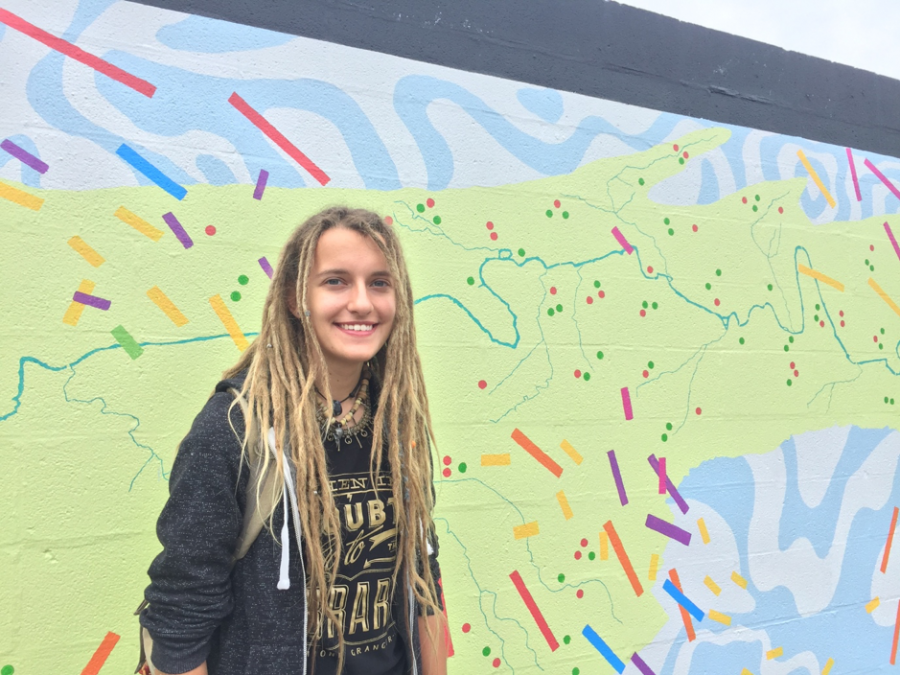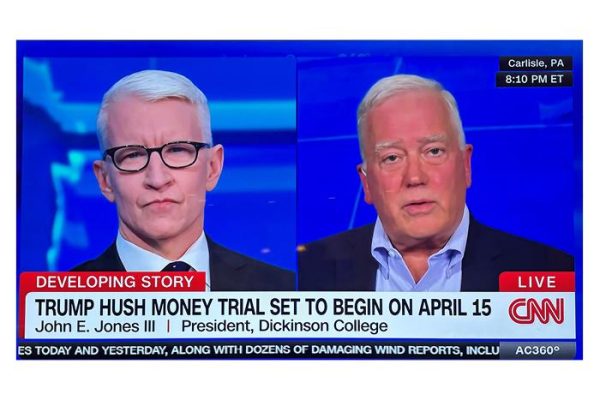Mural Integrates Art and Science
A group of art & art history Dickinson students helped Philadelphia-based artist Deidre Murphy paint a mural outside of Goodyear Gallery depicting the migration patterns of local bird populations across the Conodoguinet creek.
Murphy gave a talk in the Goodyear digital lab on Oct. 12 to explain the research that the mural is based on. Art based on bird migration has been a recurring theme in many of Murphy’s public pieces. “I connect my interest in bird migration with human migration,” she said. “We are all immigrants.”
Murphy worked with the Alliance for Aquatic Resource Monitoring (ALLARM) and the Environmental Studies department, who provided data about the Conodoguinet creek’s water quality and maps. Ornithologist and Visiting Instructor in Environmental Studies Kim Van Fleet provided data about the local bird population and an 1840s survey of local birds, according to a Sept. 26 article on the Dickinson College website.
Dickinson art students then helped Murphy paint the mural. A QR code will be painted on the wall in spring that will link to a bird survey project that is being conducted by Van Fleet, according to the article.
“The mural is a true definition of what an interdisciplinary project can look like,” said Duanduan Hsieh ’19, who helped paint the mural. “It was a blend of art and science in a form that promotes both disciplines.”
Students offered musing impressions prior to learning the meaning of the wall. Some said the thin waterline resembled a river. Most assumed the color strips were random. “It is a mad wall,” said Cell Njei ’19. “The background is a little bit hectic. It would be better if they remove the yellow, green and purple strips,” he said.
Emily Armando ’19 said “It is not obvious what it is at first.”
“It is cool that we have some representation of art around the area and a kind of more original way of showing it,” continued Armando. It is “not just a regular map but a creative one.”
“It’s pretty,” said Samantha Boswell ’19, who said the idea of mapping bird migrations is “a cool idea because not many people would pay attention to it.”
Students who helped paint the wall explained its meaning in detail. “On the wall there are the watershed, the bird migration, their nesting and overwintering path,” said Ilana Zeitzer ’19. “She [Murphy] brought with her a smaller version of the painting and came up with the general outline of the wall” explained Zeitzer.
“Students were allowed to come by on a very informal basis” to help out, said Stephanie Levin ’22. “Most of us collaborated to paint the different sections of the painting and mark the feeding and migration zones.”
“It is a dance but I really enjoy the collaborating aspect of it,” said Murphy. She spoke about the role of art educators as impactful on community through their work.
“The mural really speaks to me as someone very passionate about art, animals and the environment,” said Levin, who painted the red dot representing Carlisle.
Larrisa Babicz ’20 helped paint the mural and explained “different colors represent different kinds of birds to bring awareness that there are a lot of birds moving through.” Red is for the red tail hawk, orange for the ovenbird, and blue for the blue jay, she said.
Claire Simpson ’22 painted most of the golden stripes for Goldfinches. “The artwork leaves a cheery impression on me from all the bright colors, but I like the underlying tones of environmental factors as well,” she said.
“I was doing the green lines, which represents the Baltimore Oriole, a songbird with black head and bright orange chest” common in the northeast area, said Thu Nga Duong ’20. “The mural is not just a pretty depiction of nature, but rather makes people pay attention to the environmental issues in [the] Conodoguinet creek area.”
This project is one of many Murphy has done that incorporates science and art. Sam Fonseca ’19 said “Before I started at Dickinson I always thought art should be pretty just for the sake of art. Now I also see it is important to have some kind of significance to what you are painting.”
“It makes the work more engaging and more appealing to people. And it is a way to make viewers interact with the piece, whether by looking at it or talking about it. It’s more effective than having something that is just pretty,” Fonseca said.
Van Fleet said she first connected with Murphy about three months ago. “We looked at the change of bird population in Carlisle area between 1840 and now, relative to climate change, change in habitat and human use of the land. Deirdre was excited and said ‘give me a list of birds.’”
Public art has been part of Murphy’s practice for the last seven years. She mentions her wall paintings at the Philadelphia International airport has started the recurring theme of bird migration in her later projects. She said that for the Dickinson mural project, she was inspired by Japanese Suminagashi–floating ink–style and cartographer Harold Fisk’s Mississippi River Maps from 1944.
A time-lapse video of students and Murphy painting the six by 27-foot-long mural is available on the Dickinson College website in “Latest News” from Sept. 26, 2018.
Art Studio Technician James Krabiel, Assistant Professor of Environmental Studies Kristin Strock and the Center for Sustainability Education also contributed to the project.
More information on Murphy’s art can be found at Deirdremurphyart.com. More information about the health of the Conodoguinet creek can be found at wiki.dickinson.edu under “Nitrates in the Conodoguinet Creek.”




